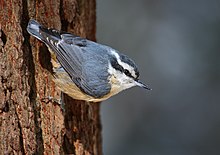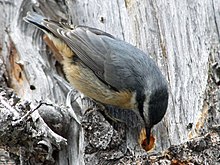Red-breasted nuthatch
| Red-breasted nuthatch | |
|---|---|

| |
| Female in Quebec, Canada | |
| Scientific classification | |
| Domain: | Eukaryota |
| Kingdom: | Animalia |
| Phylum: | Chordata |
| Class: | Aves |
| Order: | Passeriformes |
| Family: | Sittidae |
| Genus: | Sitta |
| Species: | S. canadensis
|
| Binomial name | |
| Sitta canadensis Linnaeus, 1766
| |

| |
| Approximate distribution map
Year-round
Nonbreeding
| |
The red-breasted nuthatch (Sitta canadensis) is a small songbird. The adult has blue-grey upperparts with cinnamon underparts, a white throat and face with a black stripe through the eyes, a straight grey bill and a black crown. Its call, which has been likened to a tin trumpet, is high-pitched and nasal. It breeds in coniferous forests across Canada, Alaska and the northeastern and western United States. Though often a permanent resident, it regularly irrupts further south if its food supply fails. There are records of vagrants occurring as far south as the Gulf Coast and northern Mexico. It forages on the trunks and large branches of trees, often descending head first, sometimes catching insects in flight. It eats mainly insects and seeds, especially from conifers. It excavates its nest in dead wood, often close to the ground, smearing the entrance with pitch.
Taxonomy[edit]
In 1760 the French zoologist Mathurin Jacques Brisson included a description of the red-breasted nuthatch in his Ornithologie based on a specimen collected in Canada. He used the French name Le torchepot de Canada and the Latin Sitta Canadensis.[2] Although Brisson coined Latin names for the species, these usually do not conform to the binomial system and none of them are recognised by the International Commission on Zoological Nomenclature.[3] When in 1766 the Swedish naturalist Carl Linnaeus updated his Systema Naturae for the twelfth edition, he added 240 species that had been previously described by Brisson.[3] One of these was the red-breasted nuthatch. Linnaeus included a brief description and used Brisson's name Sitta canadensis as his binomial name.[4]
Like all nuthatches, the red-breasted nuthatch is assigned to the genus Sitta (Linnaeus, 1758),[5] a name derived from sittē (σίττη), the Ancient Greek word for the Eurasian nuthatch. The specific epithet canadensis is Neo-Latin for "belonging to Canada".[6] "Nuthatch" is a linguistic corruption of "nuthack", referring to the bird's habit of wedging nuts into cracks in tree bark and hacking at them until they break open.[7] "Red-breasted" is a reference to the rusty colour of the male's underparts.[6]

In the past, the red-breasted nuthatch and four other species — the Corsican nuthatch, the Chinese nuthatch, the Algerian nuthatch and the Krüper's nuthatch — were thought to be a single species.[8] These five make up a well-defined species group known as the "Sitta canadensis group", and are sometimes considered to be a superspecies.[9] Within the species group, DNA studies have shown that the red-breasted nuthatch, the Corsican nuthatch and the Chinese nuthatch make up one clade and the Algerian nuthatch and Krüper's nuthatch make up a sister clade.[10] The red-breasted nuthatch is monotypic across its extensive range.[9]
Description[edit]
The red-breasted nuthatch is a small passerine, measuring 4.5 in (11 cm) in length,[nb 1][12] with a wingspan of 8.5 in (22 cm) and a weight of 9.9 g (0.35 oz).[13] Its back and uppertail are bluish, and its underparts rust-colored. It has a black cap and eye line and a white supercilium (eyebrow). Sexes are similarly plumaged, though females and youngsters have duller heads and paler underparts.[12]
Voice[edit]
The red-breasted nuthatch's call is high-pitched, nasal and weak. Transcribed as yenk or ink,[13] they have been likened to a toy tin horn[12] or a child's noisemaker.[14] Its song is a slowly repeated series of clear, nasal, rising notes, transcribed as eeen eeen eeen.[13]
Habitat and range[edit]
Though it is primarily a full-time resident of northern and subalpine conifer forests, the red-breasted nuthatch regularly migrates irruptively, with both the number migrating and the wintering locations varying from year to year.[12] They sometimes reach northern Mexico, where they are rare winter visitors to Nuevo León, Baja California Norte and south along the Pacific slope as far as Sinaloa.[15] In the eastern United States, its range is expanding southwards.[12] Though formerly resident on Isla Guadalupe, an island off the western coast of Mexico, it appears to have been extirpated there, with the last known record of the species on the island dating from 1971. There is a single vagrant record for Mexico's Isla Socorro.[15] It is an extremely rare vagrant to Europe, with two records in the western Palearctic; one bird successfully overwintered in eastern England.[16]
Feeding behavior and diet[edit]
Like all nuthatches, the red-breasted nuthatch is an acrobatic species, hitching itself up and down tree trunks and branches to look for food.[12] It goes headfirst when climbing down. It can "walk" on the underside of branches. Unlike woodpeckers and creepers, it does not use its tail as a prop while climbing.[17] It tends to forage singly or in pairs.[15]
The red-breasted nuthatch's diet changes depending on the season. In the summer, it eats mostly insects, occasionally even flycatching, while in the winter, it switches to conifer seeds.[18] At feeders it will take sunflower seeds, peanut butter, and suet. It often wedges food pieces in bark crevices in order to break them up with the bill (as opposed to holding the food in their feet, like the black-capped chickadee does).
Breeding[edit]
The red-breasted nuthatch, like all nuthatches, is monogamous. The male courts the female with a peculiar display, lifting his head and tail while turning his back to her, drooping his wings, and swaying from side to side.
This bird excavates its own cavity nest, 1.53–37 m (5.0–121.4 ft) above ground (usually around 4.6 m (15 ft)). Excavation is by both sexes and takes one to eight weeks.[19] The pair smears sap around the entrance hole, presumably to help deter predators.[17] The nest is lined with grass, moss, shredded bark and rootlets. Nest building is by both sexes, but mostly by the female.
The female lays 2–8 eggs (usually 5–6), which are white, creamy or pinkish, and covered with reddish-brown speckles. The eggs measure 0.6–0.7 in (1.5–1.8 cm) long by 0.4–0.5 in (1.0–1.3 cm) wide. Incubation is by the female and lasts 12–13 days.[20] The young are altricial and stay in the nest for 2–3 weeks, brooded by the female but fed by both sexes. Normally there is only one brood per year. Lifespan is around 6 years.
Conservation status and threats[edit]
Because of its large global range and its increasing population, the red-breasted nuthatch is rated as a species of Least Concern by the International Union for Conservation of Nature.[1] In the Americas, it is protected by the Migratory Bird Treaty Act of 1918.[21]
Notes[edit]
References[edit]
- ^ a b BirdLife International (2012). "Sitta canadensis". IUCN Red List of Threatened Species. 2012. Retrieved 26 November 2013.
- ^ Brisson, Mathurin Jacques (1760). Ornithologie, ou, Méthode contenant la division des oiseaux en ordres, sections, genres, especes & leurs variétés (in French and Latin). Vol. 3. Paris: Jean-Baptiste Bauche. pp. 592–594, Plate 29 fig 4. The two stars (**) at the start of the section indicates that Brisson based his description on the examination of a specimen.
- ^ a b Allen, J.A. (1910). "Collation of Brisson's genera of birds with those of Linnaeus". Bulletin of the American Museum of Natural History. 28: 317–335. hdl:2246/678.
- ^ Linnaeus, Carl (1766). Systema naturae : per regna tria natura, secundum classes, ordines, genera, species, cum characteribus, differentiis, synonymis, locis (in Latin). Vol. 1, Part 1 (12th ed.). Holmiae (Stockholm): Laurentii Salvii. p. 177.
- ^ Linnaeus, C (1758). Systema naturae per regna tria naturae, secundum classes, ordines, genera, species, cum characteribus, differentiis, synonymis, locis. Tomus I. Editio decima, reformata (in Latin). Holmiae. (Laurentii Salvii). p. 115.
Rostrum subcultrato-conicum, rectum, porrectum: integerrimum, mandíbula superiore obtusiuscula. Lingua lacero-emarginata
- ^ a b Holloway, Joel Ellis (2003). Dictionary of birds of the United States: Scientific and Common Names. Portland, OR: Timber Press. p. 185. ISBN 0-88192-600-0.
- ^ "Nuthatch". Merriam-Webster Online Dictionary. Merriam-Webster Online. Retrieved 10 May 2011.
- ^ Elphick, Dunning and Sibley 2001, p. 435
- ^ a b Harrap 2008, p. 136
- ^ Pasquet, Eric (January 1998). "Phylogeny of the nuthatches of the Sitta canadensis group and its evolutionary and biogeographic implications". Ibis (Abstract). 140 (1): 150–156. doi:10.1111/j.1474-919X.1998.tb04553.x.
- ^ Cramp, Stanley, ed. (1977). Handbook of the Birds of Europe, the Middle East and North Africa: Birds of the Western Palearctic, Volume 1, Ostrich to Ducks. Oxford University Press. p. 3. ISBN 0-19-857358-8.
- ^ a b c d e f Dunn, Jon L.; Alderfer, Jonathan, eds. (2006). National Geographic Field Guide to the Birds of North America (5th ed.). Washington DC: National Geographic. p. 341. ISBN 0-7922-5314-0.
- ^ a b c Sibley, David (2000). The North American Bird Guide. Mountfield, UK: Pica Press. p. 380. ISBN 1-873403-98-4.
- ^ Taylor, Richard Cachor (2010). Birds of Southeastern Arizona. Olympia, WA: R. W. Morse Company. p. 275. ISBN 978-0-9640810-7-9.
- ^ a b c Howell, Steve N. G; Webb, Sophie (1995). A Field Guide to the Birds of Mexico and Northern Central America. Oxford University Press. p. 553. ISBN 978-0-19-854012-0.
- ^ Dye, Keith; Fiszer, Mick; Allard, Peter (2009). Birds New to Norfolk. Sheringham, UK: Wren Publishing. pp. 340–342. ISBN 978-0-9542545-3-7.
- ^ a b Reed 2001, p. 437
- ^ Harrap, Simon; Quinn, David (1996). Tits, Nuthatches & Treecreepers. London: Christopher Helm. pp. 144–148.
- ^ Reed 2001, p. 436
- ^ "All About Birds: Red-breasted Nuthatch, Life History". Cornell Laboratory of Ornithology. Retrieved 26 May 2011.
- ^ "Birds Protected by the Migratory Bird Treaty Act". US Fish and Wildlife Service. Retrieved 16 September 2011.
Cited texts[edit]
- Reed, J. Michael (2001). "Nuthatches". In Elphick, Chris; Dunning Jr., John B.; Sibley, David (eds.). The Sibley Guide to Bird Life & Behaviour. London: Christopher Helm. ISBN 0-7136-6250-6.
- Harrap, Simon (2008). "Family Sittidae (Nuthatches)". In del Hoyo, Josep; Elliott, Andrew; Christie, David (eds.). Handbook of Birds of the World, Volume 13: Penduline-tits to Shrikes. Barcelona: Lynx Edicions. ISBN 978-84-96553-45-3.
External links[edit]
- Red-Breasted Nuthatch - Sitta canadensis - USGS Patuxent Bird Identification InfoCenter
- "Red-breasted Nuthatch media". Internet Bird Collection.
- Red-breasted Nuthatch, Hinterland Who's Who
- Red-breasted Nuthatch photo gallery at VIREO (Drexel University)
- Interactive range map of Sitta canadensis at IUCN Red List maps


